Fancy guppy 1
It wasn't untill 1916 that the first fancy specimens of guppies were introduced to the aquarium scene. That's about a decade after the first wild guppies were introduced into the aquarium scene as an ornamental species (so, not for scientific purposes).
At the beginning of the 1920's more fancy strains were available. And the first guppy shows started in the late 1920's.
Despite of the fact that I'm more a fan of non big tailed guppies, I do have to admit that I am and have been keeping big tailed guppies throughout the years. For sure there are certain big tailed guppies which will be graded the "wow-factor" by me but it's just a general thing that I'm not a huge fan of big tailed guppies.
Nevertheless, fancy guppies come in a variety of body shape, fin shape, body size and coloration. And that makes it so interesting to keep fancy guppies as well...

The large fin traits (or shapes) is something that's been generated by the so-called "Kalymma gene". The Kalymma gene has been described by J.H. Schröder (1974). The complex pattern of inheritance of the Kalymma gene needs the postulation of a suppressor gene. So, the Kalymma gene only produces large fins if a suppressor allele is absent.
Besides caudal, dorsal and anal fin, also the pectoral fins are subject to larger fins with fancy guppy breeding. Nice examples of such guppies are the so-called "big ear guppies" or also known as elephant ear guppies and dumbo guppies.
Why are many commercial bred guppies often weak?
Ever since the late teens of the 21st century, a lot of people complain about the health situation of fancy guppies they've purchased through retail. This can be explained by multiple reasons. If they're from Asian fish farms, most guppies are produced in mass production in bigger bassins. There's hardly a selection procedure which results in the fact that lots of lesser quality guppies will make the pass to be sold. And most of those guppies once they're available at the store, they're actually much younger than they look like. They're raised at Asian fish farms in a high pace. So, they may look like adults but are way younger. This means that they also have a shorter lifespan for they go through their life cycle much faster than guppies which are raised at a normal pace. The high pace ensures that the availability of such guppies is continuously which makes the commercial trade in these guppies available at all times. And the commercial trade doesn't stick to the high level of quality but are only concerned about the availability of those guppy strains. That's good enough for them. So, they can continuously offer the desired strains.
A lot of Asian fish farms also use much more salt than we would use. And also more meds as a preventive measure. But once they're sold to a foreign wholesaler or importer, those guppies are put directly in freshwater (with other water parameters than where they came from). And once a wholesaler sells them to a retailer, they land in new freshwater tanks. Each time they had to be move from water to water (with different water parameters) is already stressing them more and more. And what's mostly also going on when they come from Asian fish farms, is that they've got internal parasites or worms. All these things mentioned will result in weaker guppies that will find their way to our homes.
And I do have to say, that this doesn't only concern guppies from Asian fish farms but also other livebearers that came from Asian fish farms. I also do have to make the remark that short finned fancy guppies are stronger than large finned guppies.
Overhere in Europe, we get fish from Asian, Czech, Polish and Israeli fish farms when we consider the retail scene. But the majority will come from Asia.
I personally prefer to buy my guppies from serious private breeders instead through retail. For much more care is given to these guppies than when they came from unselected mass production.

Fancy guppies are the result of...
Nowadays fancy guppies (all breeding forms of guppies) are the result of linebreeding of crossings and natural mutations. And at first, they were all derived from "Poecilia reticulata" but nowadays, also "Poecilia obscura" and "Poecilia wingei" have been crossbred to "Poecilia reticulata" to as well to make the diversity in fancy guppies even bigger. Despite of the fact that breeding forms are labeled as being "Poecilia reticulata",if it's mixed with other influence, it should not be called "Poecilia reticulata" but "Poecilia guppy cf. or "Poecilia guppy sp." instead. Scientific names for living organisms (so, also guppies) are only given when they're pure of blood. So, officially there's no scientific name for breeding forms of guppies "when" they're not pure of blood.
Grow rate
Despite of the fact that most fancy guppies (all breeding forms) "can" have an enormous number of fry in one batch and the time period from fry to adulthood won't take that long, it's not comparable to the grow speed of a wild guppy. For most wild guppies goes it's within less than 10 weeks, fry will become adults under normal circumstances. This means that it will only take 2-2,5 months. This means also that it's possible to have 4-6 generations of wild guppies in one year. Depending on the individual female guppy, the age of becoming sexual mature may differ. For females will become sexual mature before adulthood (same goes for males). There are females that can mate at the earliest at an age of 4-6 weeks despite of their small body size.
This rate can also be done in fancy guppies by manipulating certain factors like increasing the water temperature, multiple times feeding during the day, live food, frequent water changes and sufficient open swimming space. But I would like to focus on normal conditions. Which means that the pace of growing up to adults in breeding forms will take 3-5 months (depending on the breeding form).

Above: an adult fancy female guppy of 7cm when positioned straight.
The adult size of fancy female guppies does differ a lot. Most fancy female guppies will reach a size of approx. 5cm (approx. 2 inches). But there are female specimens that will reach 7,5cm (approx. 3inches) and over.
The adult size of a male fancy guppy differ more from 2cm - 5cm. Depending on the gentics of the strain. But experience has taught that also males of 7,5cm - 8cm can develop. These are mostly late males, males that have been kept outdoors in a large environment or just very good genetics.
Below: An adult fancy male guppy of 8cm. Came from my backyard paddle pool.

Sex determination at a young age
Most people wait until fry are already grown after a couple of weeks to sex them. But it's already possible to sex them after a couple of days after birth. But it does need a good eye to see the differences at such a young age. With base colors as golden, blond and white, it can be somewhat tricky to see a tiny gravid spot that early.

Tail shapes in female fancy guppies
We all know how diverse the tail shapes of male fancy guppies can be. Of all these specific tail shapes in males, the tail shapes of females of those strains are less clear present in comparison to the males. But can we estimate to what kind of tail shape a female guppy belongs if we don't have matching male around? Yes, we can! We need to follow the contour of the female's caudal.
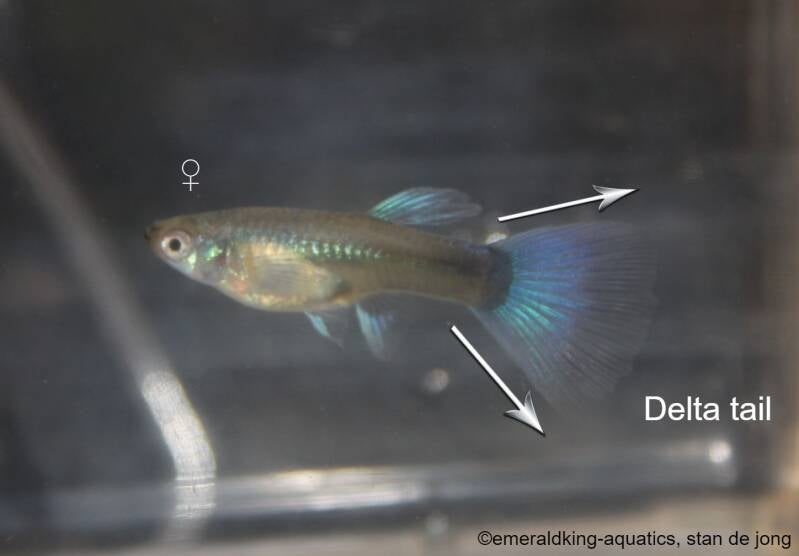
Above: A female with large caudal fin and an almost straight end of the tail. But the length of the tail tells us that she belongs to a delta-triangle tail.
Below: A female with also the contour of a delta caudal fin but with a round end.

Below: Some other tail shapes of female guppies. In males these shapes are more accurate.

Below:
A female with colored or patterned outer caudal fin rays, shows that she may come from a double sword strain. The broadness of the coloration or pattern may differ per individual female.
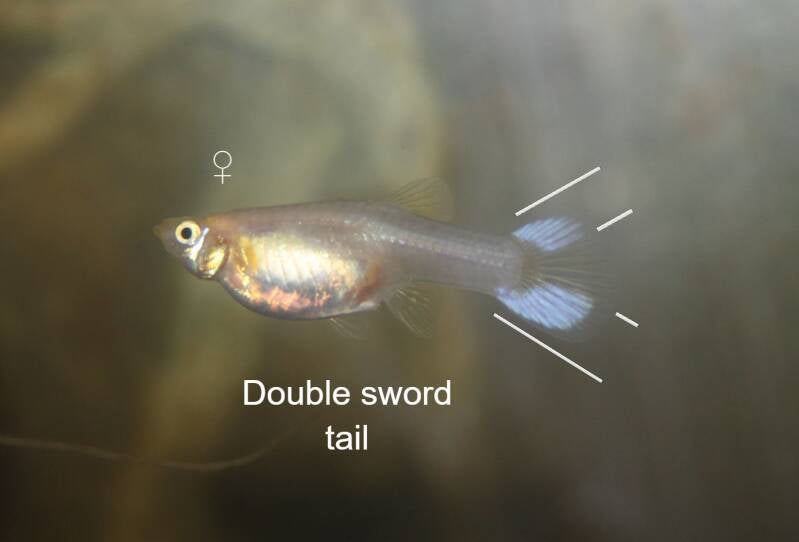
Base colors:
There are multiple base colors (primary colors) when we consider fancy guppies: grey (wild color), black (nigrocaudatus), blonde, golden, bronze, pink, opal, white, blue and asian blue. The base color grey is the most dominant base color when crossed to another base color. Unless, the specimen with a grey base color is carrying another base color (recessive gene), it may reproduce another base color in the offspring depending on the base color of the mating partner.
Note that the base colors golden, bronze and blonde may differ in names according to American, Asian and European standards.
The base colors "grey" and "blonde" are the most common ones.
Below: Base colors.



Below: Guppy fry with golden and grey based bodies.
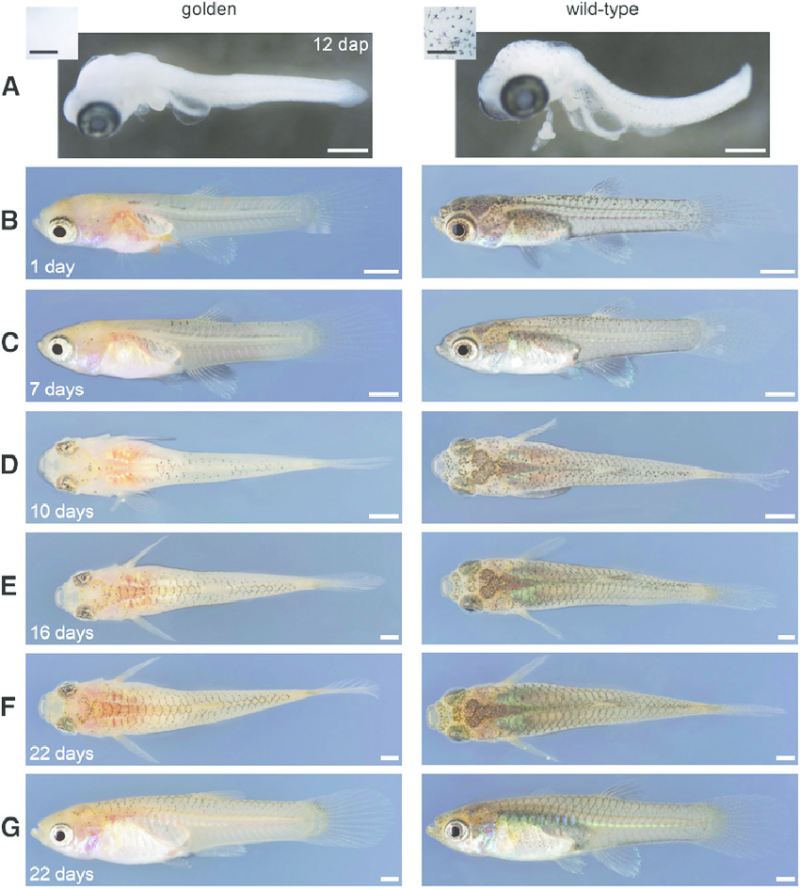

Above: A two week old nigrocaudatus type 1 bodied guppy fry. Nigrocaudatus type 1 fry are born almost black till totally black.

Above: Juvenile pink guppies (1 female/2 males)
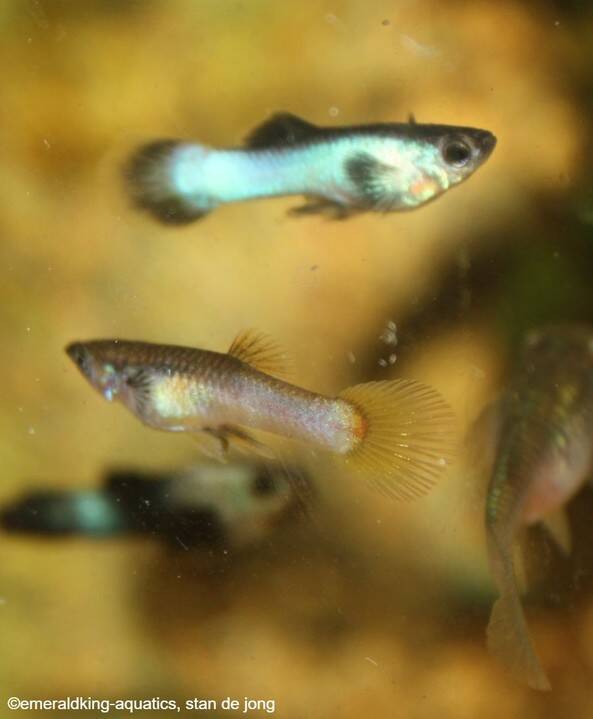
Above: Two juvenile male guppies that are both pink based despite of the fact that the upper male shows blue and black.
The term "base color" actually refers to the formation of the pigment color and its distribution in the cells present. These color cells (chromatophores) are not the color, markings or pattern that we can see with the naked eye.
Note: Certain base colors we know can be called differently in other countries. For instance blonde that's called golden in some countries. So, don't be surprised that it's not always clear with the standards that are going on.

Above:
Pigment cell types of the guppy. Xanthophores (X), melanophores (M) and iridophores (I) on the dorsal side of a guppy female shown under incident light. Leucophores could not be identified.
Scale bar: 200 mm.
(↑ Reference: Journal.pone.0085647.g001)
Xanthophores: Yellow colors cells that absorb blue light cells.
Melanophores: Dark (brown till black) color cells that absorb light across the spectrum.
Iridophores: Silvery or blue color cells that reflect light (iridescent).
Leucophores: White colors cells.
Erythrophores: Red color cells.
Note: Melanophores are capable of color change upon physiological stimuli and by transporting the melanosomes (contains melanin) along the microtubes toward the cell center. As a result they will become pale in appearance. All color cells are also different in shape as the picture above shows.
The fish skin (so, this does not apply for guppies only) consists of 3 layers.
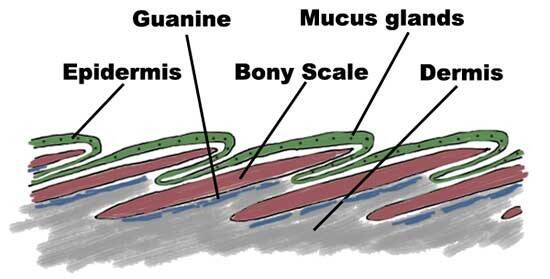

Above: The structure and function of chromatophores.
(A) Illustration of a section of skin showing the dermal chromatophore unit (modified from Bagnara et al., 1968; Bagnara and Hadley, 1973) and how the interaction of the chromatophores result in the observed reflectance spectrum of a color patch. The upper layers of xanthophores and erythrophores act to filter light and preferentially absorb short wavelengths (violets and blues). The underlying iridophores mat reflect all incident light or partially scatter light depending on the thickness, spacing and orientation of the platelets. Any remaining light is absorbed by the melanophores or reflected back through the upper chromatophores by a basal layer of leucophores (if present). If the platelets of the iridophores are arranged to reflect light of all wavelengths equally. The specimen will appear siolver, yellow, orange or red, depending on the pigment composition of the xanthophores (Grether et al., 2004). If the platelets are arranged so that light is partly reflected. This results in the specimen appearing blue if no xanthophores are present, or yellow-green, green or blue-green if xanthophores are present (Grether et al., 2004). In the context of color change, note that the dendritic processes of the melanophores extend up and terminate above the iridophores. (B) During color change on dark backgrounds, the iridophores may aggregate (leading to a reduction in the surface area of reflectance), while melanin pigmentsmove into the dendritic processes to cover the iridophores (Bagnara and Hadley, 1973). The overall effect is a chanage in the shape of the melanophore.
Thus, melanin pigments are aggregated when the specimen is placed on a pale background, making the specimen appear pale, while pigments are dispersed on a dark background, thereby darkening the skin of the specimen.
(↑ Reference: Jennifer Kelley & Wayne I.L. Davies)

Above: A layout made by Rudy Vanderstraeten which gives a good summary of the genetic genealogy table of guppy strains.
Below: Uni colored (monochrome) fancy guppies
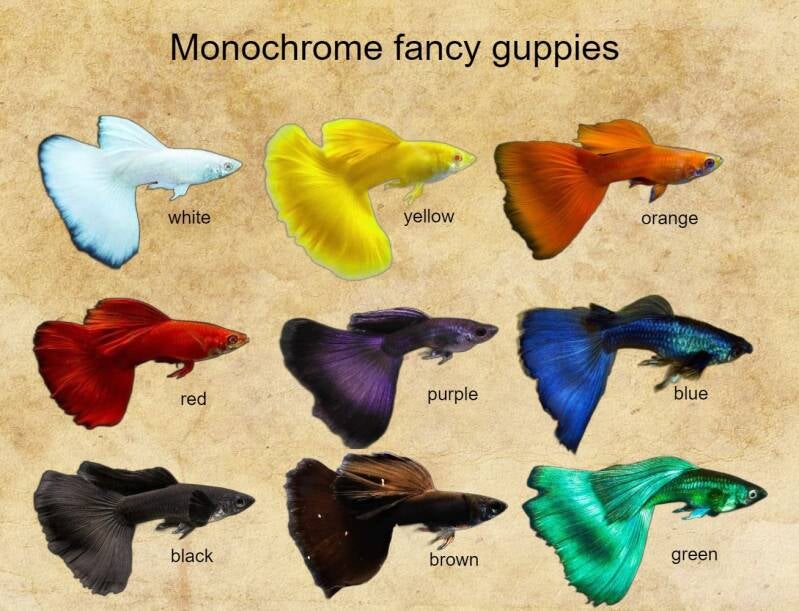
Just like female wild guppies, a lot of female fancy guppies have mainly the base color to show off. As an extra many of those fancy guppy females show color and/or pattern in their fins. The base colors are already mentioned before.It's easier for those fancy female guppies when they have somewhat color(s) or pattern that are similar to the males of the same strain to idenitfy those females. For such females are also present. But the majority of females of several fancy strains can besides the fins only show their base color on ther bodies.

Above: Adult fancy guppy females without a colored saddle.
Fortunately, there are also females that do show the base color but also a coloration like the males of the same strain on their saddles. This makes idenitying a bit easier (see photo above).
Below: Adult fancy guppy females with a colored saddle.
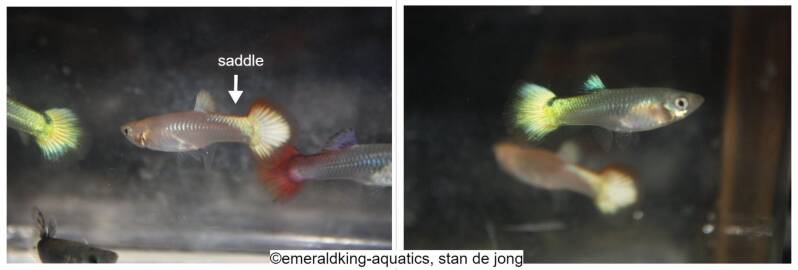
Most base colors have a dense concentration of chromatophores which makes the base color not translucent (with the exception of the spot where the gravid spot is present in females). They've got sturdy base colors. But there are also fancy guppies with an almost till a total transulcent body.In this case, the skin has got no dense concentration of chromatophores or even total lacking chromatophores.

Above: Adult fancy female guppies with a translucent body. This can occur in both sexes.
Below: Adult fancy male guppies with a translucent body.

Below: A tank with High end ritz guppies and Maple leaf guppies from breeder Kenjiro Tanaka (Japan).
Lifespan
A fancy guppy should be able to have a lifespan of 2-3 years with some exceptions that live longer. But it's commonly known that most fancy guppies derived from retail, live quite short in comparison to the actual life expectation. There are multiple reasons why this happens. One of the most important ones that most people don't realize is that most of such guppies are younger than most people think. A lot of breeders and fish farms raise guppies in a very short time span from birth. Because of their method to let those guppies grow up very fast, those guppies may look great but are not that strong than their relatives which have grown in a longer time span to become physical adults. That's one of the main reasons why people deal with short lived guppies.
A lot of commercial breeders work this way to guarantuee a continuous providing of fresh guppies to the commercial market.
Another reason is that a lot of Asian fish farms use way more salt in the breeding basins than we would do as a disease prevention. Once they're ready to be moved to another country, the importer or wholesaler puts them in freshwater. This is the first strike those guppies have to deal with. From the wholesaler to the retail, and also in freshwater. And their last trip is from retail to the fish keeper at home and also in freshwater. All those travels in between and put in freshwater while they've been in more brackish waters first will weaken those guppies.
For a lot of people think it's because of the many inbreedings they've went through. Yes, it would be a correct statement if we are dealing with guppies that have already been sold through retail and bred further at someone's home. But fancy guppies sold first time through retail are generally not weak because of so much inbreeding.
Snakeskin top sword
Well, one of my favorites are the snakeskin top swords. I've got this strain from Peter and Astrid Raschke in September 2014. This beautiful patterned fancy guppy comes in grey and blonde based bodies.
They're really vivid fish in a fishtank and now it seems very prolific as well.


Above: An adult blonde male (photo left) and we see a male at the livebearer show in Diemelsee-Adorf (Germany) (photo right).
In some way of all the snakeskin fancy strains I had, this version is the most outstanding one to me.


Moscow blue
Keeping and breeding moscows (and in generally moscow blue) has been going on in an "on & off" situation at my place. I grew up in the seventies and eighties with the old version of moscows which happened to be half greys and half blacks at that time. After 2010 the full moscows were becoming more popular. Ever since 2014 a lot of people think that the full moscows are the only real moscows there are. Well, that's because they just don't know how the moscow started off. I've read those debates so often on forums on the internet. Nowadays, we call the former moscows half black or half grey and not moscow anymore. Well, maybe I'm still old school and that's why I'm still calling those half blacks and half greys moscow as well..

If you're looking for a real full blue moscow female, be aware of it that she's the right one. Unfortunately, I've noticed that there are people who just put a half black female to a full moscow blue male. A real full moscow female has got only pigmentation in her fins. And sometimes a slight dark colored saddle.

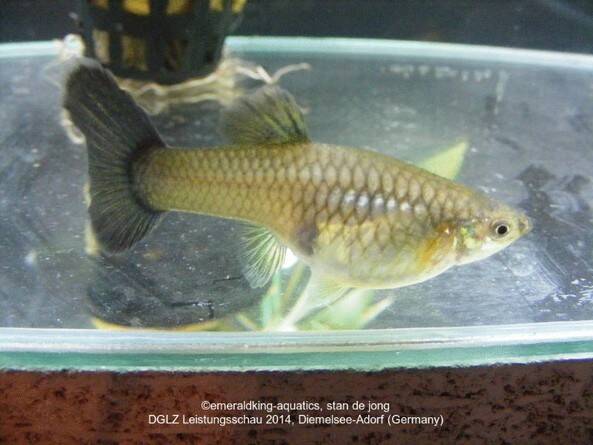
This goes the same for full moscow black and full moscow green.


The difference between moscow blue and moscow green...
Most moscow greens (specifically those that are offered through retail) are more blue with a greenish shine (see illustration above). But there are moscow green guppies that really show the green clearly like the one shown in this pic below.
Below: Top: moscow blue. Bottom: moscow green

Moscow red albino (Albino full red)
The full moscows come in a couple of body colors. One of them is the red version. And the one that got my interest is the albino version.
This is a complete copy of the full red but with the significance of the eyes. Where the regular full red has black eyes, this version has got red eyes. Just like the regular version, this is a very attractive fancy guppy.

These are born blonde and while aging the red will cover the body in total with the males. When it comes to the females, more pink till red will show up on the body. Still a good deal of the body will remain blonde. Also the dorsal of the females is a bit extended.

Females of the regular full reds are more blonde than of the albinos. That's a specific difference between these two versions. An average gestation will take about 4 weeks and a brood will count between 20 - 50 fry.

Also with this albino, it has to be mentioned that they are more sensitive in comparison to the regular full reds.
Leopard delta metalhead
I've acquired a small group of delta leopard metalhead guppies from my friend Kees de Jong. The ones I've started with were quite young. It took a while before the tail of the male grew out as a real delta tail.

The females show some pattern in their dorsal and caudal. But their bodies are plain grey. The ones of my stock have beautiful ferm build. Which is also preferable when developing a big tail (referring to the males). A more slender body in combination with a large tail, will cause a bent body at some point. For the tail is to heavy and it will cost such a guppy to move forward a lot of energy. Mostly this will end in a short lifespan. Fortunately, mine are more ferm which is a good thing regrading the health of the fish.

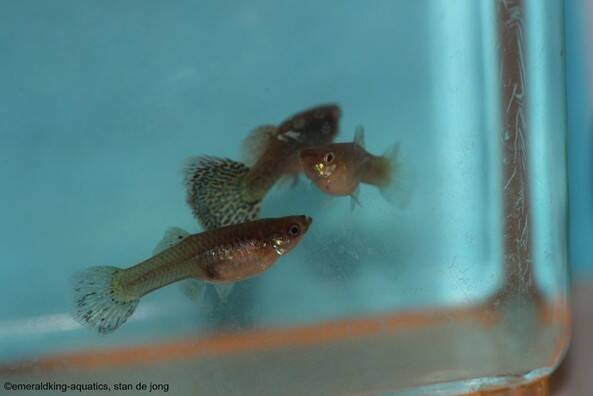
Koi guppies
Koi guppies are created in japan. They come in several varieties. Because the name "koi guppy" refers to the Japanese koi (the Japanese name "koi" means colored carp), patterns and coloration of such guppies are also named after the patterns and coloration of the koi, like sanke, showa, kohaku, etc...
Below: Several varieties of koi guppies.






Above & below: My own created full red koi guppy (grey based).


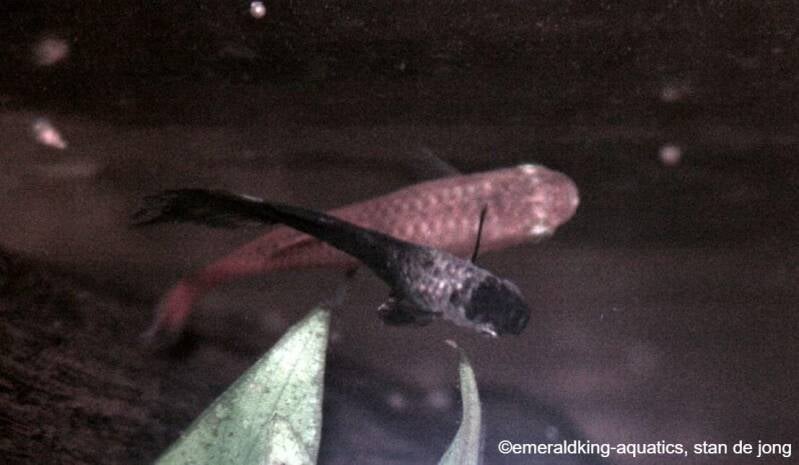

Above & below: My own created black koi guppy.



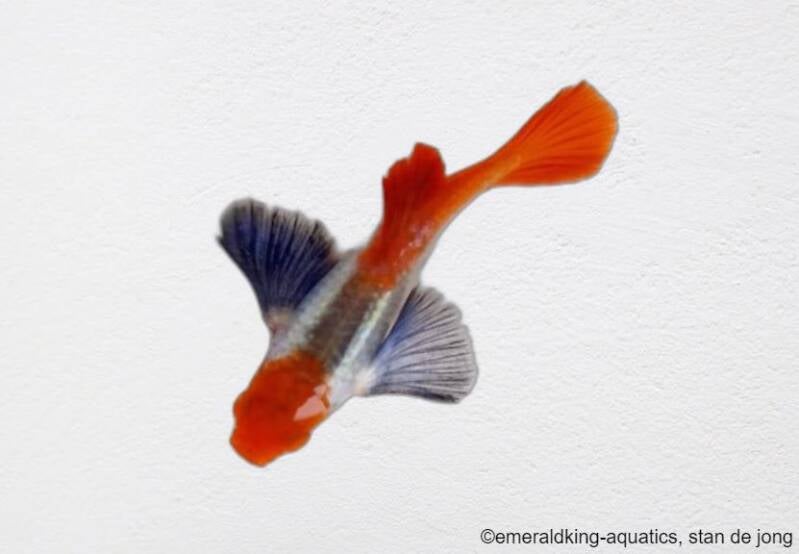
Above: Blond albino blue koi guppies.(left picture) and a Dumbo platinum red koi guppy ♂ (right picture).
Below: A male Siam blue koi guppy. A solid color guppy with a colorful texture on its head and tail. This beautiful fancy strain has been developed in Thailand. A black color and bluish component is a common feature of this guppy species.

In general, in Japan the koi fish is associated with positive traits and attributes. Among the traits it symbolizes are: good fortune, success, prosperity, longevity, courage, ambition, and perseverance. Let's hope that koi guppies also relate to these traits...
Albino koi guppy (Kohaku)
Also a very interesting fancy guppy is the albino koi guppy. This strain has been created in Japan. Although, they already existed for much longer, I just saw them for the first time for real back in 2014 at one of the livebearer shows I've participated. Before that I just knew them from pictures.


The albino koi guppy which I'm keeping and breeding concerns a kohaku version (bicolor) and is blonde based. Although I haven't found out what the real origin (when it comes to genetics) of this strain happens to be, it does relate to the full red strain.
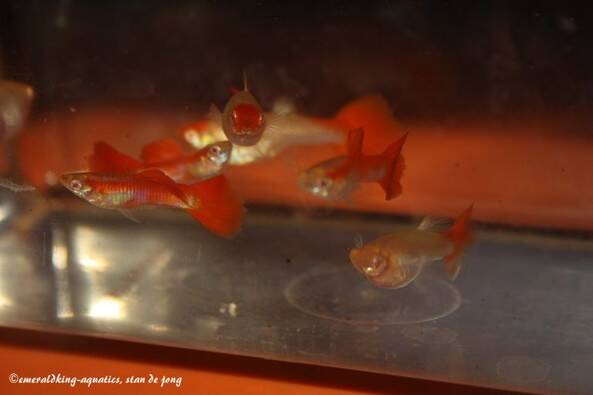

The male does show a red pattern all over his body. Especially the upper part (saddleback, shoulder and head is red covered. The chest and the lower backside will show blonde. Of course, an ideal male would be having a blonde body with just red fins and a lipstick marking on the nose. And maybe just a slight red marking on the saddle. Unlike the full red guppy, the gonopodium won't show any red coloration.
The females show a lot less red markings on their bodies. Very characteristic with females is the red nose. Such a marking on the nose or lips is called kuchibeni (which means lipstick in Japanese just like they name koi with such a marking). And most females won't show any red dorsals but translucent ones or white.
I do prefer this strain in comparison to the king koi guppy. The king koi guppy known for its lionhead doesn't appeal to me. King koi guppies are also known as "Ranchu guppies" and "Lion head guppies". With a goldfish such a head would be okay because of the way the body's build. But a slender fish like a guppy, such a deformity doesn't do a guppy any justice in my opinion. But that's a matter of personal preference.

Above: A female king koi guppy. This tumorous (the hump on the head is in fact a tumor) variety also comes in other color varieties (picture taken by Tarzan78, member of Aquatic quotient forum).
Tuxedo red koi guppy
The Tuxedo red koi guppy is a color variety of the regular Tuxedo red guppy. Only difference is the red nose or lipstick marking (kuchibeni).

One other typical issue is that the coloration of the female's dorsal isn't always full red but can be partially red or white-bluish.

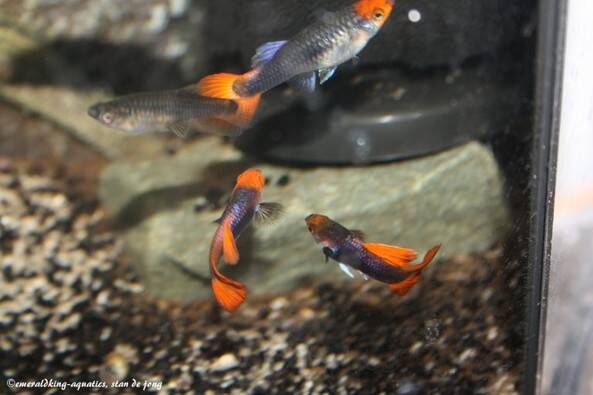
In comparison to the albino koi guppy, the tuxedo red koi has got more contrast. The intensity of the dark bodied parts goes from dark grey to blue till black. And putting them in daylight, you'll be able to see a lot of blue shimmer... Even on the caudal penducle.


Platinum koi guppy
Another variety of the koi guppy is the platinum koi guppy. They come in grey and blonde based.
In comparison to albino koi and tuxedo red koi, the males do have better red or orange coloration in their fins in comparison to the females. Especially the coloration of the caudal fin of the females may differ per individual.

It's a very interesting variety because of the platinum body of the male. But also the pattern and coloration of each male specimen does differ no matter grey or blonde based.


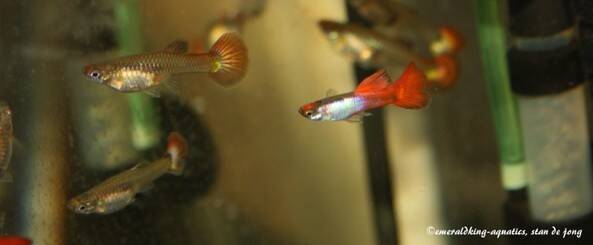
Above: A trio of grey based platinum koi guppies.
Below: A blonde based male platinum koi guppy.
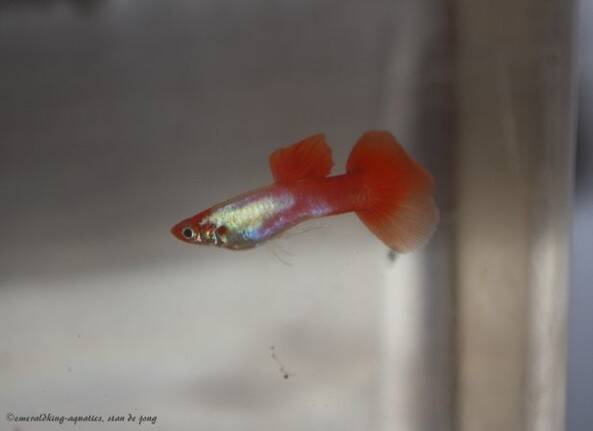
Snow White roundtail
Ever since the November 2016 I've started to focus on keeping and breeding Snow White guppies).These blonde based guppies are the cheaper equivalent of the large tailed platinum white guppies. But in general I do prefer short tailed guppies. And so I've decided to focus on round tail whites. The difference between the large tailed platinum whites and these Snow Whites is that the Snow Whites are developed from magenta guppies which were carrying the Störzbach gene. If you'll cross a male Snow White guppy to a blond non Snow White female, you'll notice that the magenta (partially or total covered) will show up again in the male and sometimes the female (in females mostly shown on the saddle) offspring.

Depending on the light used in a tank, they can show a bluish shimmer as well. The tip of the nose of the male will keep the blonde color. In some way, I'm not able to get that part covered in white as well. Nevertheless, it remains a stunning fancy guppy.


In comparison to the delta tail platinum white guppies, the dorsal of this strain is kept shorter. Could be that in time that I'll be aiming on a somewhat extended dorsal. In general most males are round tails but from time to time also some spadetails do occur.


It's remarkable that there are two types of females within this strain. There's a total blonde bodied one with translucent finnage. And there are females that are blonde bodied with white finnage It's seriously one of the more challenging strains I keep. My goal is to manage to make real full whites out of them. For it will always be, that there will be males that don't have a white nose.
Yellow taxi glass belly
Like all glass belly guppies, also these are translucent around the belly area for they are lacking pigmentation of the abdomen. Which means also that the pregnancy development can be followed optimally. This albino version does lack black pigment by all means.

But besides a possible pregnancy also the internals like a colon can be seen through the skin (last mentioned goes for both genders of course). My own opinion is that they're not so prolific as most fancy guppies. But maybe that's something that just happens at my own place. Maybe somewhere else they might be a bit more reproductive...



In general most males of this strain are delta tail males. But from time to time also swallow and ribbon males do occur like the male shown above.


Above: A pregnant glass belly female with embryos shining through that are almost ready to be born.
Left: A pregnant glass belly female with developing embryos shining through.
Japan blue lyretail
Japan blue lyretails are as magnificent as their short tailed relatives. The males can have double swords, a bottom sword or a top sword. The variation of the sword colour can range from blue, black, white, red or orange.

Also the length or the width of the sword(s) can differ. Below a male with a short bottom sword is shown.

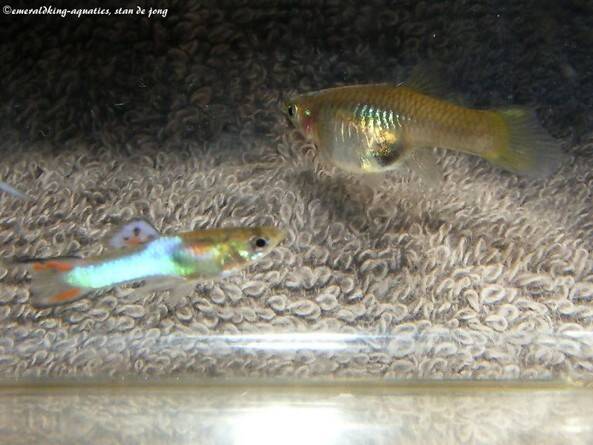
But also endler influences are used with japan blue guppies like the second picture above shows. The black bar is typical an influence coming from an endler bloodline.
In 2015 one of my own japan blue lyretail (blue fin) entries for the Livebearer and Killifish Convention in Asperen (the Netherlands) won the third position (category fancy guppies). In fact, my entry and two other entries were scored all to be the winner within the same discipline. But there can only be one winner in each category. So, an extra judging took place to make a serious top 3. Mine was elected to be third.


An entry of my japan blue lyretail (blue fins) at the International Endler Championship 2013 in Berlin (Germany) wasn't qualified being top 3 but it was being published in the International Guppy Fachjournal January 2014 as being a japan blue "wingei" variety.
Snakeskin (cobra) sharktail
As the name already suggests, this guppy strain has got cobra pattern on its body and a tail shape of a shark's tail. To me this variety of a cobra fancy guppy is much more fascinating than a delta tailed one. But this is a personal preference of course...


This strain is very prolific and for sure fast growers. Further on, they're quite hardy. The dot on both sides of the chest is a specific mark to this strain.
Dwarf panda guppy
Although panda guppies were already known for a longer period of time, they just became more popular back in 2012. Way before that period I only had the opportunity to purchase males and no females. A bit hard to breed the line without the right females. Fortunately, after a few years also females of this fancy strains were at hand. One of the reasons why I've started keeping them again. Another reason is the size of the males. I'm really fond of smaller guppies (btw, females tend to get the same size as a regular female guppy).

Although, the name "panda" seems very logical because of the "black&white" combination, there are sufficient males which are almost fully black covered.
The influence of pink and moscow is also noticeable when the male is younger before the black markings have fully colored up. And also with most females there's a slight pink noticeable at the rear part of the body. And as the picture above shows, also somewhat pink on the head (not all females show this pink on the head). It's also the pink gene that will keep the body length short. But there's also a bigger version of the panda guppy. But that strain doesn't carry the pink gene. And the females of the bigger panda guppies are grey based with dark till black fins and saddle. And of course, the males of the bigger panda guppies are also grey based instead of pink.
Note: It's a genuine guppy and no endler hybrid! The commercial trade has called them "endlers" ever since that the endler hype is going on. Before the endler hype they were correctly labeled as being guppies. And again, it's the pink gene that keeps the body short...


Most males also tend to have a blue shine on their body when light reflects on them.
They're easy breeders once they're comfortable in their environment.


There are also normal panda guppies. The normal ones are bigger. The males look exactly like the dwarf panda guppies but they're a bit bigger in size. The females however are different from the females of the dwarf pandas. Instead of pink guppies, the females of the normal panda guppies are bigger in size and show the black moscow traits in the fins and saddle.
Lutino panda
A panda variety which seems to be a bit more vulnerable is the so-called lutino panda. This variety is lacking melanophores and shows on a blonde or white body a white coloration. Also some dark pink and/or a bluish shine may appear in the fins and/or caudal penducle.
Despite of the fact that this strain has been launched on the market as being lutino, it doesn't match the genetics. Besides pink, there's also blue in it. In my opinion naming it opal albino panda, would be a better choice. This would also match the intensity of the red eyes.

Like most albinos and lutinos, these pandas are more vulnerable to fungus and other infectious diseases. But despite of the vulnerability, it's really worthwhile to keep this strain.


Above: Two adult females (photo left). The left female is a white bodied female in comparison to the blonde bodied female (right).
The first ones I've kept was back in 2016.
Platinum panda blonde
Another panda variety is the so-called platinum panda blonde. This is a blond bodied species where only the males will show further coloration. The male shows black colored fins and a white platinum coloration which covers the blonde body.


Males tend not to color up at the same pace. Some males do show already black fins as being fry. And most males will show color once they're juveniles. The males can show some green and/or blue on the caudal penducle...
Below: A couple of blonde platinum pandas.


Second picture above: Males of different ages.
The typical scale net pattern on top of a pink guppy female is also shown on these blonde females. Which shows as well that the pink gene is actually present.

This variety has proven to be very prolific.
Vienna emerald double sword
Vienna emerald guppies have their foundation decades back in old Viennna, Austria. Starting off as delta guppies. Afterwards, swordtail varieties became more popular because of the body pattern became more prominent. For there was hardly pattern in the caudal with swordtail varieties. With the deltas, the pattern in their caudal happened to be so prominent, that the pattern on the body became less noticeable. Personally, I do prefer swordtail varieties instead of deltas.


One of the typical traits of Vienna emerald guppies is the so-called meander pattern. Typically, present on both flanks or chest. This pattern looks like a joint pattern of waved lines. And yes, the other typical trait is the green on the caudal penducle. So, the name Vienna emerald is derived from to the location of origin and the green caudal penducle. Another trait is the peacock mark. This mark can be visible on the chest, shoulder, flanks or caudal penducle. That differs per male. But on blonde based ones, the peacock doesn't always shine through clearly. And with the so-called blonde based "bunt" (German for variegated) varieties, the peacock is mostly left out.


The Vienna emerald guppy is one of my favorite (and in my opinion the most beautiful guppy) fancy guppies there is.
Vienna emerald lower sword blonde
In 2014 I've started keeping these blonde lower swords after I've purchased a group from Frank Schenk (Fisch und Heim, Voerde in Germany)
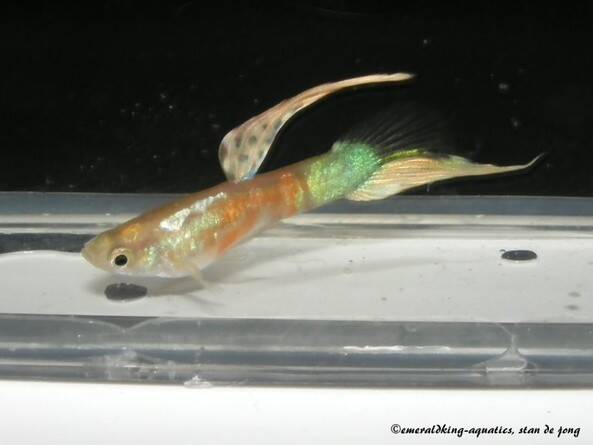
It took a reasonable period of time before they were reproducing themselves but after a couple of months, they started dropping fry. They do like clean water and a more frequent water change is preferable.
They're really stunning fancies with a metallic shine all over the body. Features of yellow, green, orange or even red markings are present. Just like the lower sword als the dorsal is extended and with the yellow colour on the dorsal also some spots are shown.


A true jewel indeed...!
Vienna emerald double sword blonde
The blonde double sword version is almost the same as the lower sword variety. But mine are more golden. Overhere a couple of pictures of them.



These doubleswords come in short swords and elongated swords. These blondes are the bunt variety.
Filigree double sword blonde

During fall 2016 I've started keeping this strain. It's a remarkable stunning double sword guppy. For it also shows somewhat pink and a bluish shimmer. Pink is mostly present in the male's dorsal, two swords and the top of the body. Some females have clear fins and others have some slight bluish markings in both dorsal and caudal fin. And some pinkish on the female's saddle is present.


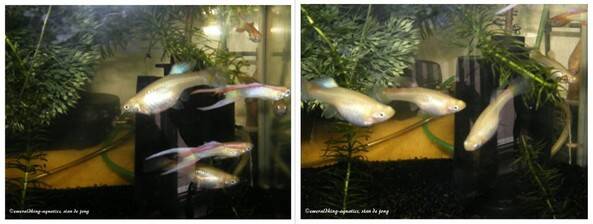
They're quite hardy fish to keep and for sure prolific.
High end Ritz lace DS
Another creation of Japanese breeder Kenjiro Tanaka is the High end Ritz lace guppy. This is a double sword fancy guppy available as being gray or blonde based. The gray based version is also called Ritz green lace DS because of the green shimmer on its body; depending how the light is shining upon the fish.


This strain seems very prolific and quite hardy. So, in general a very easy kind of guppy. In general I do keep both grays and blondes joined in one tank. This to keep the pattern well balanced on those blondes. Same thing with the Ginga rubras.


It's a very interesting kind of guppy when you look at coloration on the male's body with the metallic shine. Also the filigree pattern in both dorsal and caudal fin makes it a stunning fish.
Big ear / Dumbo guppy / Elephant ear
Well, there are more names for this kind of guppy. It refers to their big pectoral fins. All dumbo guppies carry the kalymma gene which is responsible for the large pectoral fins. Mostly those pectoral fins will be black but can have other colors as well. Even translucent.
There are many color varieties. I've kept some of these guppies and they can be very colorful. At least they'll show a beautiful contrast.
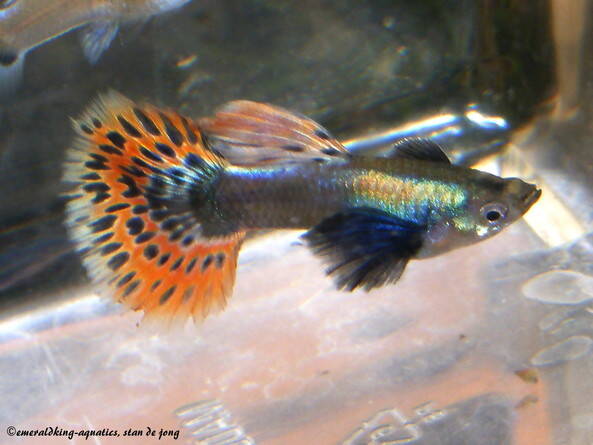
Saw the first specimens live when I was meeting up with David Teng from Singapore at the Marriot Hotel in Amsterdam back in spring 2014. Before I just knew them from videos and pictures.
Below: A female dumbo guppy. Second picture shows an adult multicolor male.
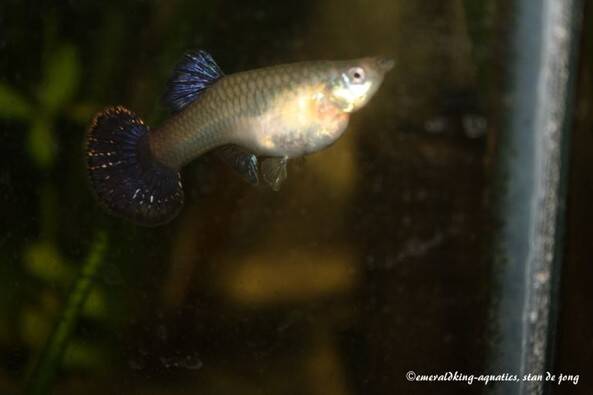
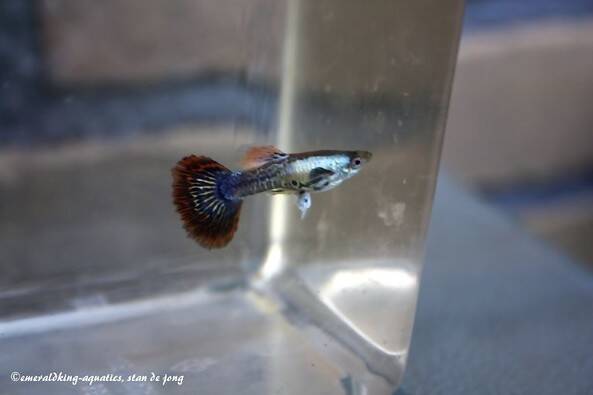
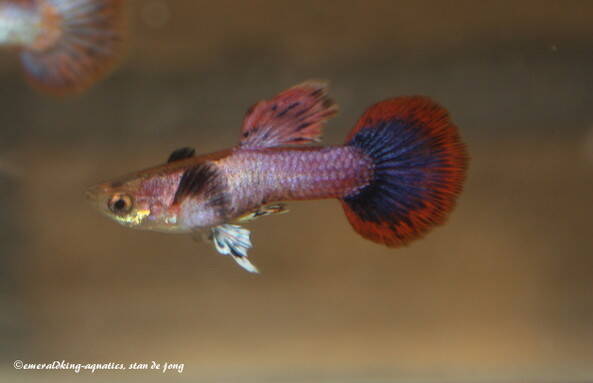
Above: A beautiful magenta dumbo roundtail male.
HB gold
A cross between half black (grey based) guppies and gold guppies resulted in this HB gold guppy. At this point (2016) I've noticed that it seems still rare in Western-Europe (which will probably change within the coming year). For I had the impression that a similar specimen was already available for a reasonable time.

Sometimes a regular half black still develops within this group. That will probably become less after a couple of generations.
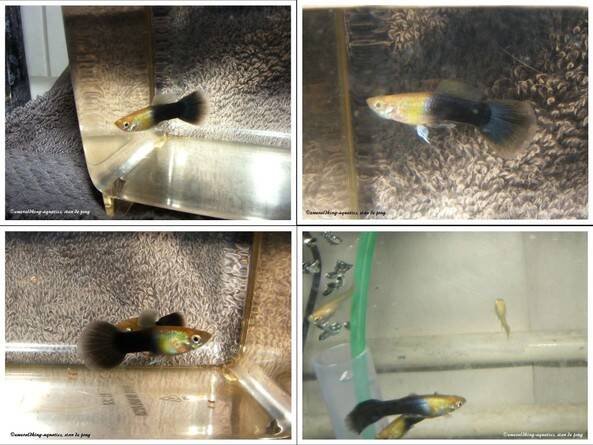

The tail shape per individual male does differ from a small delta till round tail...

